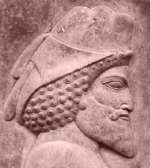Persian and Hellenistic Armenia
The Achaemenids, Orontids and Macedonians
Tour Armenia
THE ACHAEMENIDS THE MACEDONIANS
The Achaemenids
Almost immediately following the collapse of Urartu, the tribes in the Armenian plateau reorganized into a new kingdom, the Armen or Arameh. The earliest records of the name were made by the Greek historian Hecataeus of Miletus (ca. 550 BC), who called them the Armenoi. Some thirty years later their country is designated as Armina in the inscription of Darius I at Behistun (Bisitun). In part of the Book of Jeremiah, which modern scholars date ca. 594 BC, the prophet calls together, against Babylon, 'the kingdoms of Ararat, Minni and Aschchenaz'. At that time Urartu, incorporated into the Median Empire, was no longer a separate kingdom, but its name persisted, for the Babylonian version of the Behistun inscription uses "Urartu" in the place of "Armina".
Much debate has been made about how the Armenian tribe, thought to be a separate ethnic group of Hurrian or Hattian origin to the West of Urartu, could so quickly usurp the Urartian empire. Considering the close ties between all the tribes in the Armenian plateau, and their cultural intermingling, it is now believed the Armenians and the Urartians were more distant cousins than distinct ethnic groups. What is known is that the transfer of power did not cause any serious eruption in the nation: language, religion and traditions continued as they had under the previous kingdom. Though falling under the rule of the Medes, the Armenians re-asserted their primacy over Urartian territories.
The Persian conquest of the Medes (a forerunner tribe of the Kurds), led by the Achaemenid Cyrus the Great, established Persia as a regional power, incorporating the Armenians into the empire. As part of the Persian Empire, Armenia was divided into provinces called satrapies, each with a local governing satrap (viceroy) supervised by a Parthian. The thirteenth satrapy organized by Darius I was called Armina or Arminya, but did not constitute the entire region. An 18th satrapy made up of Alarodians (remnants of Urartians), Mateinians and Saspirians, stretched to the Arax River valley, and was soon incorporated into the Armenian territories. Armenians paid tribute to the Persians, who continually requisitioned silver, rugs, horses and military supplies.
Never fully subdued, the Armenian Kingdom continued to expand its power, so that constant alliances were required to maintain the Achaemenid borders. By 401-400 BC, when Xenophon and the Ten Thousands passed through, the entire basin of the western Tigris and the Euphrates/Arsenias probably lay within the boundaries of Armenia. Xenophon called the area Armenia, ruled by Orontes. The Orontid Dynasty (related to the Achaemenids through countless inter-marriages) is the first great dynasty of the Armenian Kingdom, ruling as satraps from 401 BC until 331 BC, when they became kings. The names of many of the satraps and kings are preserved in inscriptions on the monument of Nimruth Dagh, erected by Antiochus I.
Armenian Orontid Kings
 Xenophon throws light on the social structure of the time in his Anabasis. Clans constituted the basic structure of society, with their chiefs (known as elders or comarkhs) ruling from fortified rural settlements which owed allegiance to the satrap, who had authority over the entire kingdom. Part of the tribute paid to Persia were horses, which, according to Xenophon, were smaller but more fiery than those of the Persians. Agriculture was very developed, for in all the settlements the Ten Thousand found abundant supplies of wheat, barley, green vegetables, various oils and wines. They were feasted with lamb, goat, pork, veal and fowl, different types of bread and a special beverage, made with barley (there's the beer!), which they drank through a straw. The people lived in underground dwellings with narrow openings in the top, through which they entered by means of a ladder, though the palace of the satrap was described as being surrounded by many others with towers. Xenophon throws light on the social structure of the time in his Anabasis. Clans constituted the basic structure of society, with their chiefs (known as elders or comarkhs) ruling from fortified rural settlements which owed allegiance to the satrap, who had authority over the entire kingdom. Part of the tribute paid to Persia were horses, which, according to Xenophon, were smaller but more fiery than those of the Persians. Agriculture was very developed, for in all the settlements the Ten Thousand found abundant supplies of wheat, barley, green vegetables, various oils and wines. They were feasted with lamb, goat, pork, veal and fowl, different types of bread and a special beverage, made with barley (there's the beer!), which they drank through a straw. The people lived in underground dwellings with narrow openings in the top, through which they entered by means of a ladder, though the palace of the satrap was described as being surrounded by many others with towers.
Armenians participated in the Persian wars against Greece, and were an important linchpin in Persia’s aspirations to conquer the West. Never able to completely subdue the Armenians (who were never able to completely assert their independence), especially after the defeat of Xerxes in the Greek wars, the Persians and Armenians began a 200 year wary co-existence, sharing culture and royal blood ties through intermarriage. Persian Zoroastrian beliefs influenced Armenian religion, which absorbed its features into some of their polytheistic and animistic beliefs, though the pantheon of Armenian gods basically remained the same. At the same time, the Persians absorbed Armenian astronomical, mathematical and geometrical sciences.
The Macedonians
 In 334 BC, Alexander Macedonia (Alexander the Great), with an army of 40,000 men, invaded Asia Minor, determined to topple the Persian Empire. Within 3 years he had defeated the Persian king Darius III, and destroyed the Persian capital of Persepolis. With the fall of the Persian Empire in 331 B. C., the Macedonians appointed a new satrap, Mithranes from the Orontid royal house, to govern Armenia. Alexander’s army moved to the edges of the known world in India before his troops forced him to stop his conquests and return. In 334 BC, Alexander Macedonia (Alexander the Great), with an army of 40,000 men, invaded Asia Minor, determined to topple the Persian Empire. Within 3 years he had defeated the Persian king Darius III, and destroyed the Persian capital of Persepolis. With the fall of the Persian Empire in 331 B. C., the Macedonians appointed a new satrap, Mithranes from the Orontid royal house, to govern Armenia. Alexander’s army moved to the edges of the known world in India before his troops forced him to stop his conquests and return.
After Alexander's sudden death in 323 BC, the partitioning of his empire and warring among his generals led to the emergence of three Greek kingdoms. Armenia fell under the rule of Seleucis in 311 BC, establishing the co-called Seleucid Era. Despite pressure from the Seleucids, the Orontid dynasty continued to control the largest of three kingdoms into which Armenia had been divided: Greater Armenia, Lesser Armenia and Sophene.
Hellenism was perhaps Armenia's greatest cultural influence, becoming so deeply ingrained into the culture that characteristics continue to the present day. Greek language became the language of court, Greek inscriptions having been uncovered at Armavir, the first Orontid capital, founded in the Ararat Valley on the site of the Urartian City of Argishitinili. The inscriptions indicate the existence of a Greek temple of Apollo and Artemis, served by a predominantly Greek priesthood. However, one inscription found in 1927 has been interpreted as bearing an address from Mythras, high priest of the Temple of the Sun and Moon, to his brother, King Orontes IV. Temples to the sun and moon were not a common feature of Classical Greek religion, though they had been a feature of Armenian religion since the Paleolithic Period.
Assimilation of Greek ideals was facilitated by earlier Indo-European influence on the Greek culture itself, the Greeks having some of the same roots as Armenians and sharing an early Greek-Armenian Language community. The Armenians would have found much to identify with in the Hellenistic culture which shared the zodiac, pantheon of the gods and traditions. Armenian culture absorbed Greek philosophy, architecture and pantheon of gods, giving Armenian deities Greek names, and eventually, their human likeness.
During Orontes IV's reign, the royal residence was transferred from Armavir to Yervandashat, located on a rocky promontory close to the confluence of the Akhurian and Arax rivers. The city was fortified with high walls, within which the rock was hewn to the level of the river, allowing fresh water to enter the city. Iron staircases led to the bronze gates of the citadel, and into these traps were built as a safeguard against any attempt against the king's life. The king's treasures were moved to Yervandashat, but religious idols were lodged in a small town built further north on the left bank of the Akhurian River. This town was named Bagaran, meaning 'the city of the gods or idols'. Both cities still exist in Armenia, albeit as villages with no excavations.
The Orontids ordered the planting of a large forest to the north of the river, stocking it with numerous animals for the chase. And they reintroduced ancestral Armenian's quest for contact with new lands by developing the commerce routes linking Central Asia with the Black Sea and the Mediterranean. Lying on focal points on this trade route, Armavir and Yervandashat were richly endowed cities. Thousands of drachmas and Alexandrian tetradrachms, gold staters and Seleucid coinage uncovered in Armenia show a very rich country.
Orontid rule came to an end when a local prince, Artashes (Artaxias), overthrew Orontes, seized the capital at Yervandashat, and became master over the greater part of the kingdom.
Artashesian Dynasty
The Romans allowed two former Seleucid satraps to set up rival Armenian states, but following the defeat of Antiochus III by Romans in the battle of Magnesia (190 BC), Artashes declared himself King of Greater Armenia in 189 BC, building a capital at Artashat (Artaxa), called 'the joy of Artashes'.
Situated on the Arax River 30 km south of Yerevan, excavations of the site and nearby Khorvirab Monastery still exist.
Artashes attempted but failed to seize the neighboring kingdom of Sophene after the death of its king Zariadris. Despite this he forged a kingdom almost covering the whole of the Armenian Plateau: from the Euphrates in the west, to within reach of the Caspian Sea, and from the Caucasus in the North to the Taurus Mountains. Like the Urartian Empire before it, the Armenian kingdom rose in the face of the world’s greatest powers, only this time the two powers were the new Persian (Parthian) Empire and Rome.


 Top
Top

|
